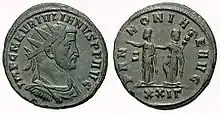Julian of Pannonia
Marcus Aurelius Sabinus Julianus,[1] known in English as Julian of Pannonia (died 285–286) was a Roman usurper (283–285 or 286) against Emperor Carinus or Maximian. It is possible that up to four usurpers with a similar name rebelled in a timeframe of a decade, but at least one of them is known by numismatic evidence.
| Julian of Pannonia | |||||||||
|---|---|---|---|---|---|---|---|---|---|
| Usurper(s) of the Roman Empire | |||||||||
.png.webp) Aureus of Julian minted c. 284 | |||||||||
| Reign | 283–285 or 286, against Carinus or Maximian | ||||||||
| Died | Italy or Africa Province | ||||||||
| |||||||||

Usurper against Carinus (283–285)
Julian was a corrector in northern Italy, in 283/284,[2] (and not a praetorian prefect as stated by some sources).[3] Soon after the news of the death of Emperor Carus[2] (in 283) or Numerian[3] (in November 284) arrived in the western provinces, Julian revolted in Pannonia. He issued coins from Siscia, some of them bearing a legend celebrating Pannonia. Emperor Carinus, brother of Numerian, who had marched from Roman Britain to deal with the usurpation, met, defeated, and killed Julian early in 285, in Italy[4] (possibly in Verona),[5] or in Illyricum.[2]
According to some scholars, it is possible that two usurpers actually existed: a Marcus Aurelius Julianus, corrector in Italy, rebelled after Carus' death, with the control of Pannonia, and defeated in Illyricum; and a Sabinus Julianus, praetorian prefect, usurper in Italy after Numerian's death, defeated near Verona.[6]
Another usurper, simply named Julian, raised some turmoil in Africa Province, against Carinus, with the support of the Quinquegentani tribe.[7]
Usurper against Maximian and Diocletian
A third Julian is mentioned revolting between the time Maximian had been raised to the rank of Augustus (1 March 286) and the time Constantius Chlorus and Galerius became Caesar (March 1, 293). The revolt of this Julianus took place in Italy, but ended when, during a siege, a breach was opened in the walls of his city, and he threw himself in the fire.[8]
Notes
- His name is known from his coins, where his name is given as "M. Aur. Iulianus", and from literary sources: Aurelius Victor (Epitome, 38.6) and Zosimus (1.73; 1.3) give "Sabinus Julianus"; "Julianus" is supported by Aurelius Victor, Liber, 39.10.
- Aurelius Victor, Liber, 39.10.
- Zosimus, i.73.1.
- Zosimus, i.73.3.
- Aurelius Victor, Epitome, 38.6.
- Morris.
- Aurelius Victor, Liber, 39.22.
- Aurelius Victor, Epitome, 39.3-4.
References
Primary sources
- Aurelius Victor, Epitome de Caesaribus, 38.6, 39.3-4
- Aurelius Victor, Liber de Caesaribus, 39.10, 39.22
- Zosimus, Historia Nova,
Secondary sources
- Banchich, Thomas, and Michael DiMaio, "Iulianus (ca. 286-293 A.D.)", De Imperatoribus Romanis
- Leadbetter, William, "Carinus (283-285 A.D.)", De Imperatoribus Romanis
- Morris, John; Arnold Hugh Martin Jones; John Robert Martindale (1992). The prosopography of the later Roman Empire. Cambridge University Press. p. 474. ISBN 0-521-07233-6.